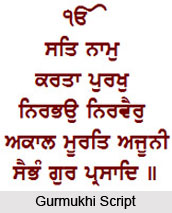 Descending from the Later Sharada script, the Gurumukhi script was designed by the second Sikh guru, Guru Angad Dev in the 16th century for writing the Punjabi language. Gurmukhi is a style of writing called an abugida where each consonant has a natural vowel (a) that can be changed using vowel signs. One thousand four hundred and thirty pages of Guru Granth Sahib are written in this script. The modernized Gurmukhi script has forty-one consonants, nine vowel symbols, two symbols for nasal sounds and one symbol, which is the duplicate sound of any consonant. Gurmukhi has been adapted to write other languages such as Braj Bhasha, Khariboli, Sanskrit and Sindhi.
Descending from the Later Sharada script, the Gurumukhi script was designed by the second Sikh guru, Guru Angad Dev in the 16th century for writing the Punjabi language. Gurmukhi is a style of writing called an abugida where each consonant has a natural vowel (a) that can be changed using vowel signs. One thousand four hundred and thirty pages of Guru Granth Sahib are written in this script. The modernized Gurmukhi script has forty-one consonants, nine vowel symbols, two symbols for nasal sounds and one symbol, which is the duplicate sound of any consonant. Gurmukhi has been adapted to write other languages such as Braj Bhasha, Khariboli, Sanskrit and Sindhi.
The name Gurmukhi came from an old Punjabi term `guramukhi` which means `from the mouth of the Guru`. With the penning of the Guru Granth Sahib in Gurmukhi, it became the principal script for the other literary works of the Sikhs. It was in the 20th century that the script was designated as the official script of the Eastern Punjabi language while for the Western Punjabi language the official script was Shahmukhi.
The Gurmukhi alphabet consists of thirty-five distinct letters. The Gurmukhi script has its own set of numerals, which is somewhat similar to the Hindu-Arabic numerals.



















